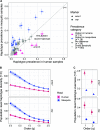Plasmodium falciparum Genetic Diversity in Coincident Human and Mosquito Hosts
- PMID: 36073811
- PMCID: PMC9600619
- DOI: 10.1128/mbio.02277-22
Plasmodium falciparum Genetic Diversity in Coincident Human and Mosquito Hosts
Abstract
Population genetic diversity of Plasmodium falciparum antigenic loci is high despite large bottlenecks in population size during the parasite life cycle. The prevalence of genetically distinct haplotypes at these loci, while well characterized in humans, has not been thoroughly compared between human and mosquito hosts. We assessed parasite haplotype prevalence, diversity, and evenness using human and mosquito P. falciparum infections collected from the same households during a 14-month longitudinal cohort study using amplicon deep sequencing of two antigenic gene fragments (ama1 and csp). To a prior set of infected humans (n = 1,175/2,813; 86.2% sequencing success) and mosquito abdomens (n = 199/1,448; 95.5% sequencing success), we added sequences from infected mosquito heads (n = 134/1,448; 98.5% sequencing success). The overall and sample-level parasite populations were more diverse in mosquitoes than in humans. Additionally, haplotype prevalences were more even in the P. falciparum human population than in the mosquito population, consistent with balancing selection occurring at these loci in humans. In contrast, we observed that infections in humans were more likely to harbor a dominant haplotype than infections in mosquitoes, potentially due to removal of unfit strains by the human immune system. Finally, within a given mosquito, there was little overlap in genetic composition of abdomen and head infections, suggesting that infections may be cleared from the abdomen during a mosquito's lifespan. Taken together, our observations provide evidence for the mosquito vector acting as a reservoir of sequence diversity in malaria parasite populations. IMPORTANCE Plasmodium falciparum is the deadliest human malaria parasite, and infections consisting of concurrent, multiple strains are common in regions of high endemicity. During transitions within and between the parasite's mosquito and human hosts, these strains are subject to population bottlenecks, and distinct parasite strains may have differential fitness in the various environments encountered. These bottlenecks and fitness differences may lead to differences in strain prevalence and diversity between hosts. We investigated differences in genetic diversity and evenness between P. falciparum parasites in human and mosquito hosts collected from the same households during a 14-month longitudinal study in Kenya. Compared to human parasite populations and infections, P. falciparum parasites observed in mosquito populations and infections were more diverse by multiple population genetic metrics. This suggests that the mosquito vector acts as a reservoir of sequence diversity in malaria parasite populations.
Keywords: Plasmodium falciparum; comparative genomics; genetic diversity; malaria; transmission.
Conflict of interest statement
The authors declare no conflict of interest.
Figures



References
-
- Sumner KM, Freedman E, Abel L, Obala A, Pence BW, Wesolowski A, Meshnick SR, Prudhomme-O'Meara W, Taylor SM. 2021. Genotyping cognate Plasmodium falciparum in humans and mosquitoes to estimate onward transmission of asymptomatic infections. Nat Commun 12:909. doi:10.1038/s41467-021-21269-2. - DOI - PMC - PubMed
-
- Mharakurwa S, Kumwenda T, Mkulama MAP, Musapa M, Chishimba S, Shiff CJ, Sullivan DJ, Thuma PE, Liu K, Agre P. 2011. Malaria antifolate resistance with contrasting Plasmodium falciparum dihydrofolate reductase (DHFR) polymorphisms in humans and Anopheles mosquitoes. Proc Natl Acad Sci USA 108:18796–18801. doi:10.1073/pnas.1116162108. - DOI - PMC - PubMed
-
- Conrad MD, Mota D, Musiime A, Kilama M, Rek J, Kamya M, Dorsey G, Rosenthal PJ. 2017. Comparative prevalence of Plasmodium falciparum resistance-associated genetic polymorphisms in parasites infecting humans and mosquitoes in Uganda. Am J Trop Med Hyg 97:1576–1580. doi:10.4269/ajtmh.17-0351. - DOI - PMC - PubMed
Publication types
MeSH terms
Grants and funding
LinkOut - more resources
Full Text Sources
Medical

